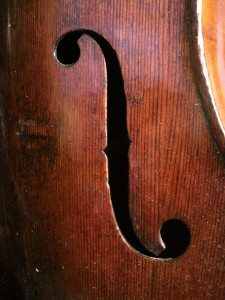I know it doesn’t have anything to do with string instruments…..but this is how I stay sane and healthy while spending long hours at the bench. I am a member of a 4.5 level (probably just below teaching pro) over 50 age USTA tennis team that plays out of a small clay court club called Logan in Elkins Park PA. By winning our district -we got to play in Princeton NJ for the Middle States (PA-NJ-DE) -and we won some tough matches – I was part of a pivotal doubles win. By winning there we were invited to play at the National Championships in Palm Springs CA for a week in the late fall at the most gorgeous country club I have ever seen! Wow – playing tennis all morning in the desert sun and lounging at the pool dissecting matches with my team mates in the afternoon. Unfortunately, all that strategizing didn’t help against some very stiff competition – but you leave it all out on the court….including the grunting and the swearing (quietly). Ideally, I then get back to the bench thoroughly refreshed and ready to sit still for long hours at a time


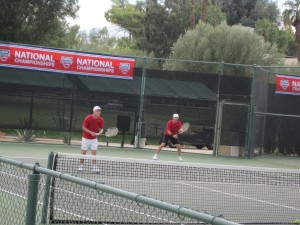
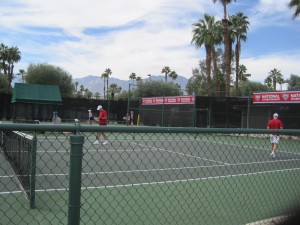
Beautiful Giuseppe Lucci 1972 cello
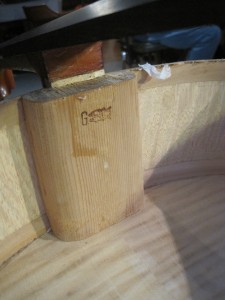
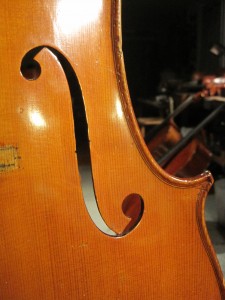
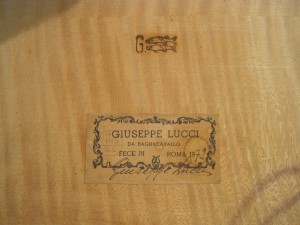 I am working on a fine cello by Giuseppe Lucci dated Roma 1972. With the top off we get a nice close-up view of his label and whimsical brand ( which refers to the “fishy” origin of his name). It was last sold through the Moennig shop to the distinguished cellist/teacher Metta Watts who has accepted the fact that she no longer needs such a fine cello. I worked on this cello many times during the years when I did all the cello work at the shop – though there was never time or the crying need to do all that could be done to make it look and sound at its very best. Now in my own shop I am able to change the bass bar and take care of all the other things inside -then, once the top is back on and I will be touching-up and restoring the”
I am working on a fine cello by Giuseppe Lucci dated Roma 1972. With the top off we get a nice close-up view of his label and whimsical brand ( which refers to the “fishy” origin of his name). It was last sold through the Moennig shop to the distinguished cellist/teacher Metta Watts who has accepted the fact that she no longer needs such a fine cello. I worked on this cello many times during the years when I did all the cello work at the shop – though there was never time or the crying need to do all that could be done to make it look and sound at its very best. Now in my own shop I am able to change the bass bar and take care of all the other things inside -then, once the top is back on and I will be touching-up and restoring the” lustrous light golden orange colored varnish” ( as justly stated on the Moennig paper). Its interesting to know an instrument for a long time and see the time is come for it to be in the hands of a player who can do justice to all its power and complexity.
lustrous light golden orange colored varnish” ( as justly stated on the Moennig paper). Its interesting to know an instrument for a long time and see the time is come for it to be in the hands of a player who can do justice to all its power and complexity.
A family affair
Ricardo Morales (and Victoria) watch Amy Oshiro (wife & mother) play on her beautiful Telosphore Barbe c 1880 that they acquired from me. This Barbe was one of the principal workers in the Vuilluame workshop and it bears many similarities to the violins coming out of that great shop. Only later in his life did he make instruments that have his his label. Accompanying this violin is a great letter from the noted French maker Gustave Bazin stating this was the finest example of T Barbe’s work that he had ever seen.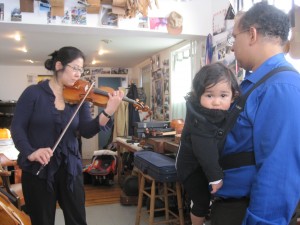 Amy tells me she uses the violin very often for her playing in the Philadelphia Orchestra where she feels it warmth and power projects beautifully…..and when Ricardo agrees too you know you have a good fiddle!
Amy tells me she uses the violin very often for her playing in the Philadelphia Orchestra where she feels it warmth and power projects beautifully…..and when Ricardo agrees too you know you have a good fiddle!
You might think Ricardo would be busy and immersed enough with his role as principal clarinet of the Philly O…..well you would be wrong. His boundless enthusiasm spills (or gushes) into the violin world – bringing an endless interest in instruments, character of sound, makers and just about everything else relating to string instruments.I think in a big way this is just an outgrowth of his lifetime of fussing over his clarinets – and that that endless search has now evolved into violins.
As he builds a collection of some of the finest new violins being made today its a pleasure to help him adjust, work on and admire along with him what these great things can do.
A fascinating coming together
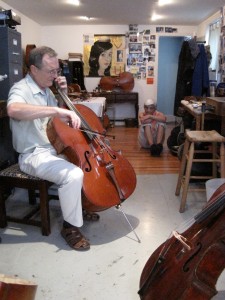 David Cole – son of Orlando Cole (and a distinguished cellist/teacher in his own right) is seen here playing a cello made by William Moennig Jr in 1939 which is a copy of his father’s celebrated Montagnana cello known as “The Sleeping Beauty” Sitting watching him play is Metta Watts , longtime assistant to Mr Cole and for decades the owner of this cello. It is now owned by a protege of hers who is an aspiring cellist. The cello happened to be in my shop for bushing (filling with wood) the old peg holes and reaming them out to fit new pegs.The Montagnana model is the broadest cello model whose small,stubby F-holes are swallowed up in the wide expanse of the breast area of the top
David Cole – son of Orlando Cole (and a distinguished cellist/teacher in his own right) is seen here playing a cello made by William Moennig Jr in 1939 which is a copy of his father’s celebrated Montagnana cello known as “The Sleeping Beauty” Sitting watching him play is Metta Watts , longtime assistant to Mr Cole and for decades the owner of this cello. It is now owned by a protege of hers who is an aspiring cellist. The cello happened to be in my shop for bushing (filling with wood) the old peg holes and reaming them out to fit new pegs.The Montagnana model is the broadest cello model whose small,stubby F-holes are swallowed up in the wide expanse of the breast area of the top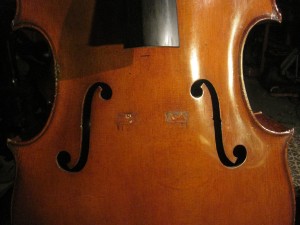
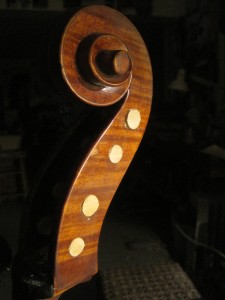
New bridge for playing a concerto
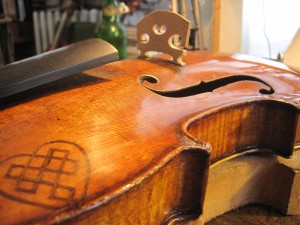 C J – the principal violist of the Philly O will be playing the Walton concerto in front of the orchestra. In preparing for it he asked me to do all I could to make it look and sound its best.Among other things, we decided to try a new higher bridge. You don’t simply work on C J ‘s viola – you collaborate . He has very strong ideas – and I always like the urgency and intensity that he brings to it. I find myself constantly learning by this kind of interaction with players – each player and instrument is different and success requires different approaches all the time
C J – the principal violist of the Philly O will be playing the Walton concerto in front of the orchestra. In preparing for it he asked me to do all I could to make it look and sound its best.Among other things, we decided to try a new higher bridge. You don’t simply work on C J ‘s viola – you collaborate . He has very strong ideas – and I always like the urgency and intensity that he brings to it. I find myself constantly learning by this kind of interaction with players – each player and instrument is different and success requires different approaches all the time 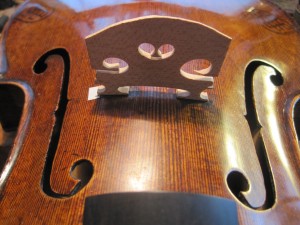
Jaime Amador – Violist in the San Juan Symphony
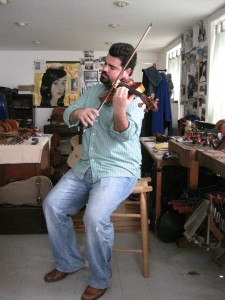 Jaime is trying out his beautiful Italian viola after some extensive work. He is such a great player who draws a big,rich sound out his viola its a treat just to hear him play scales. He is currently trying a few new Haide violas that I have worked on thoroughly – making them all they can possibly be. It sounds like the Maggini copy is getting a lot of work in the Orchestra and Chamber concerts. High praise from a very discerning musician.
Jaime is trying out his beautiful Italian viola after some extensive work. He is such a great player who draws a big,rich sound out his viola its a treat just to hear him play scales. He is currently trying a few new Haide violas that I have worked on thoroughly – making them all they can possibly be. It sounds like the Maggini copy is getting a lot of work in the Orchestra and Chamber concerts. High praise from a very discerning musician.
Latest bridge
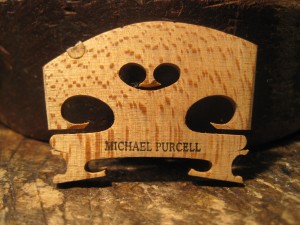
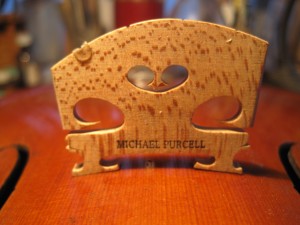 I’m finishing up this bridge for a very nice Antoniazzi violin. The bridge is a crucial part of the sound, playability and character of any string instrument and it demands the utmost skill for it to be all it should be. It first has to endure the immense string tension down and remain upright through it all. Its next purpose is to transfer the strings vibrations to the top as efficiently as possible. To perform both these roles effectively the bridge must have enough wood -with no extra to get in the way – and it must be in all in the right places. I think of it like an athlete – it must have all the muscle it needs and no fat. Lastly it must have style and personality which only comes from a sharp blade and a skilled hand. When all is done I hold my breath and brand it – hoping that I got my name on straight
I’m finishing up this bridge for a very nice Antoniazzi violin. The bridge is a crucial part of the sound, playability and character of any string instrument and it demands the utmost skill for it to be all it should be. It first has to endure the immense string tension down and remain upright through it all. Its next purpose is to transfer the strings vibrations to the top as efficiently as possible. To perform both these roles effectively the bridge must have enough wood -with no extra to get in the way – and it must be in all in the right places. I think of it like an athlete – it must have all the muscle it needs and no fat. Lastly it must have style and personality which only comes from a sharp blade and a skilled hand. When all is done I hold my breath and brand it – hoping that I got my name on straight
Lorne Munroe’s second cello suffers a fall
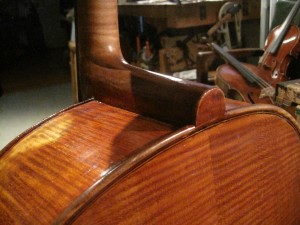
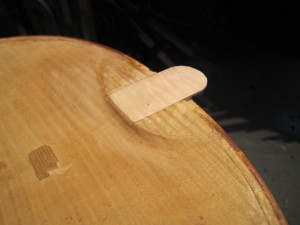 This cello belongs to the great Philadelphia cellist Lorne Munroe. It was made for him by Thomas Elmer in Philadelphia in 1960. Unfortunately it suffered a fall and the neck pulled out at the button and to make things more difficult the piece of the back known as the button – which is glued to the neck- has separated at the purfling and stayed attached to the neck stock. In order to do this repair properly the back must come off and the button must be carefully removed from the neck and reglued to the back. Then the break will be discretely reinforced with new wood spanning the break.The back then is glued back on and the button area is ready for varnish touch up that will make the break invisible – which should make you think twice and look very close when buying an old instrument! Lastly, the neck is reset, the varnish is restored and to the untrained eye nothing has happened.
This cello belongs to the great Philadelphia cellist Lorne Munroe. It was made for him by Thomas Elmer in Philadelphia in 1960. Unfortunately it suffered a fall and the neck pulled out at the button and to make things more difficult the piece of the back known as the button – which is glued to the neck- has separated at the purfling and stayed attached to the neck stock. In order to do this repair properly the back must come off and the button must be carefully removed from the neck and reglued to the back. Then the break will be discretely reinforced with new wood spanning the break.The back then is glued back on and the button area is ready for varnish touch up that will make the break invisible – which should make you think twice and look very close when buying an old instrument! Lastly, the neck is reset, the varnish is restored and to the untrained eye nothing has happened.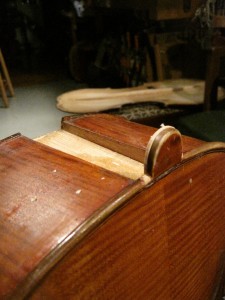
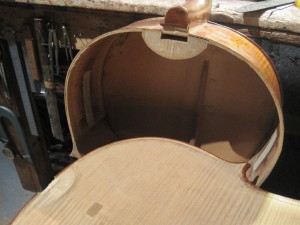
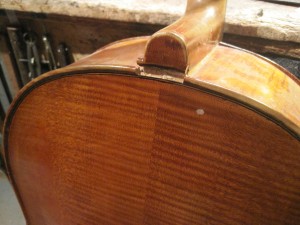
Bumpy ride on Southwest Airlines
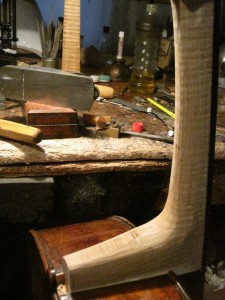
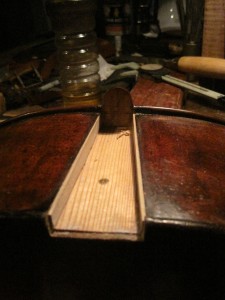
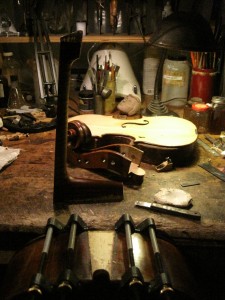 They may be good at moving people inexpensively, but they are certainly not to be trusted with fine musical instruments. This fine, early 19th century German cello was in a very sturdy shipping case when it must have been dealt a stunning blow. Luckily the damage was mostly confined to where the old neck graft joined the scroll. The new graft will carefully clean up all the ragged wood and restore the cello to its previous fine state and value. First the scroll needs to be cleaned up , with the sides of the pegbox flattened and prepared to accept the new neck. Next is the tricky job of getting the old neck out of the body. You carefully(!) make a saw cut just inside the button and work an opening knife along the joint where the neck stock joins the ribs. When you have loosened the neck all around you put clamps on the ribs adjacent to the neck – then the bold part of giving the neck a swift shot to one side. This will release the joint underneath the neck stock – but not without a dramatic (and heart stopping) thwack. This is the glue letting go of the joint between the end grain of the neck (which really is not a very strong joint) and the mortise of the top block. Now its time to prepare the mortise and fashion a new neck.
They may be good at moving people inexpensively, but they are certainly not to be trusted with fine musical instruments. This fine, early 19th century German cello was in a very sturdy shipping case when it must have been dealt a stunning blow. Luckily the damage was mostly confined to where the old neck graft joined the scroll. The new graft will carefully clean up all the ragged wood and restore the cello to its previous fine state and value. First the scroll needs to be cleaned up , with the sides of the pegbox flattened and prepared to accept the new neck. Next is the tricky job of getting the old neck out of the body. You carefully(!) make a saw cut just inside the button and work an opening knife along the joint where the neck stock joins the ribs. When you have loosened the neck all around you put clamps on the ribs adjacent to the neck – then the bold part of giving the neck a swift shot to one side. This will release the joint underneath the neck stock – but not without a dramatic (and heart stopping) thwack. This is the glue letting go of the joint between the end grain of the neck (which really is not a very strong joint) and the mortise of the top block. Now its time to prepare the mortise and fashion a new neck. 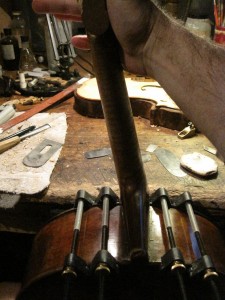
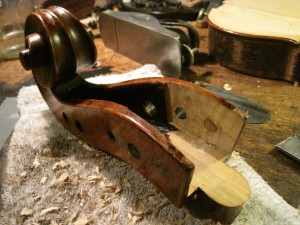
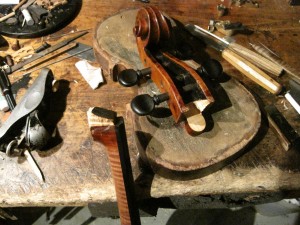
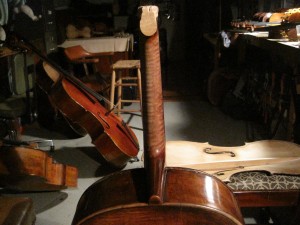
Beautiful 18th century Italian cello
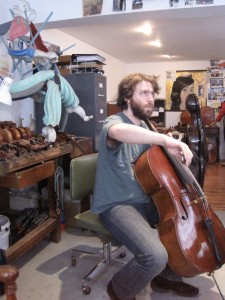
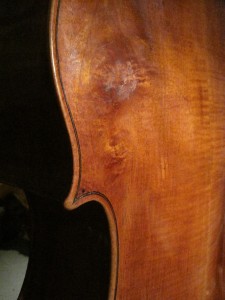
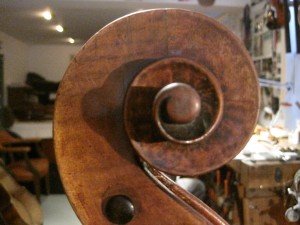
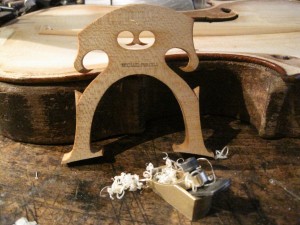 A beautiful cello owned by the famed Guildhall School in London was in my studio recently for some extensive gluing and a new bridge. We decided on a Belgian bridge for its ability to give a cello more punch and bold clarity of sound. With its higher legs and compressed torso the bridge gets to the height it needs to be with less wood than the traditional French bridge blank so there is less material in the way as the bridge transmits the sound from strings to body. The sculptor in me loves cutting these blanks with their graceful leg curves and jaunty, military bearing. The cello itself is a treat to behold with its rugged sculptural power, bold craftsmanship and subtle, artistic details. Bart Lafollette , the promising young cellist who has had the use of this cello treats me to a Bach suite while trying out the “new” cello – He claims it has never sounded better – high praise from him and the fact that the cello has spent time in the finest shops in London. Bart will be recording with the Doric Quartet in London and playing solo gigs in England and on the continent. Its great to be able to help him fill the hall with his great musicality.
A beautiful cello owned by the famed Guildhall School in London was in my studio recently for some extensive gluing and a new bridge. We decided on a Belgian bridge for its ability to give a cello more punch and bold clarity of sound. With its higher legs and compressed torso the bridge gets to the height it needs to be with less wood than the traditional French bridge blank so there is less material in the way as the bridge transmits the sound from strings to body. The sculptor in me loves cutting these blanks with their graceful leg curves and jaunty, military bearing. The cello itself is a treat to behold with its rugged sculptural power, bold craftsmanship and subtle, artistic details. Bart Lafollette , the promising young cellist who has had the use of this cello treats me to a Bach suite while trying out the “new” cello – He claims it has never sounded better – high praise from him and the fact that the cello has spent time in the finest shops in London. Bart will be recording with the Doric Quartet in London and playing solo gigs in England and on the continent. Its great to be able to help him fill the hall with his great musicality.
